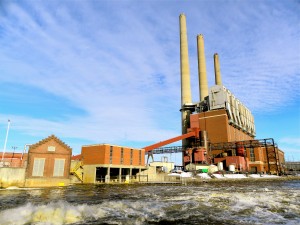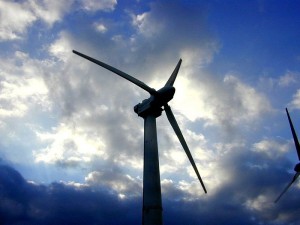
Energy officials say it’s cheaper to close a coal plant down than retrofit it. Photo: Jennifer Kalish.
The gradual closure of coal-fired power plants in Great Lakes states has utilities looking at options for workers no longer needed to operate them.
Power generators say closing such plants comes as the result of a federal rule aimed at curbing mercury and other toxic pollutants from coal- and oil-fired power plants by 2015. The rule requires the installation of pollution control equipment, switching to cleaner energy sources or shutting down coal plants, according to the EPA.
Apart from the federal regulations, utility companies are building windfarms and power plants operating on natural gas that are cheaper than coal.
Officials at Ohio’s FirstEnergy say it is more cost effective to retire the coal plants than retrofit them.
Federal regulations and other environmental rules make the coal plants less cost-effective, said James H. Lash, President of First Energy.
Last winter the company announced closure of five coal-operated plants around the Great Lakes region, four in Ohio and one in Pennsylvania. It is closing another one in Maryland.
In total, 529 employees are affected. Some will be considered for open positions at other FirstEnergy facilities, the company reports. Eligible employees around 55 years and older will be offered incentives to retire early.
Lash said the decision to close the plants is “not in any way a reflection of the fine work done by the employees at the affected plants.”
Dominion, one of the nation’s largest power suppliers, was also forced to close and decommission its Kewaunee Power Station in Carlton, Wis. The plant will cease power production in the second quarter of 2013.
“Kewaunee’s power purchase agreements are ending at a time of projected low wholesale electricity prices in the region,” said Thomas Ferrell II, chief executive officer of the company.
In 2011, the station was put up for sale but didn’t find a buyer. These factors make it unprofitable for Kewaunee to continue operations, Ferrell added.
It employs 655 people and the workforce will continue to ramp down by about a third, said Jim Novelle, spokesperson for the Dominion.
“We plan to retain a sufficient number of employees long term to operate the station safely through shutdown,” he said. “Beyond that, employees can apply for any open vacancy within the Dominion.”
The company manages gas and power distribution stations in 15 states nationwide.
Novelle noted that employees will receive retention benefits, a compensation package offered beyond salary and wages through the shutdown and severance benefits when they leave.
Michigan’s Consumers Energy is expecting a net loss of employees by 2015. Meanwhile, the company is considering reassigning some workers to it’s other power plants.
Jeff Holyfield, director of news and information for Consumers Energy, said the company is looking at possibly retraining and transferring employees to natural gas operated plants and windfarms.
As the EPA rules came forward, the company cancelled a proposed clean coal plant project near Bay City and announced the suspension of another seven small coal operated units by 2015. The units employ about 300 people.
Holyfied said the company plans to mothball those units for another three years. That means they will be shutdown but ready to resume operation if conditions change.
“We need some workforce to maintain the sites in good working condition in case if the plant will be turned around in the future,” he said.
The company’s first wind-farm, located in Mason County, enters service in 2012. Another one in Tuscola County starts

Wind is a growing alternative energy sector in Michigan.
operating in 2015, when the seven coal plants shut down.
“Retraining is an option. If the employee will qualify they can work at another unit,” Holyfield said.
The windfarm’s longterm operation requires about 10-15 people. Construction of the facility provides about 150 jobs, said Holyfield.
Employees will also be able to transfer to the company’s natural gas distribution stations.
“We’re working with are union leadership to come up with the best solutions to provide jobs to our employees,” Holyfield said.
The International Brotherhood of Electrical Workers, a union representing utility workers across the nation, is concerned that finding work around the Great Lakes will be difficult once the plants shutdown.
“The workforce at coal-fired plats will not simply transition to renewable energy jobs because the latter won’t be created fast enough,” said Jim Spellane, media director for the union.
The union supports legislation, not to overturn the EPA rules, but to coordinate a transition to renewable energy with the least impact on the workforce.
DTE Energy, another Michigan power company, is suspending operation of its Harbor Beach Power Plant on Lake Huron by 2013.
All 24 employees at the plant will be offered positions at other DTE Energy facilities, said Scott Simons, spokesperson for the company.
Related story: Alternative energy and jobs
Anonymous, coal plants are closed as necessary and different people get employed. You need electricity whether burning garbage or coal, not 50 comments on kayaking. The employed help the unemployed.
More people on unemployment. How’s that hopey-changey stuff workin’ out for ya? At least you gots an Obamaphone.
Two old coal-fired plants in Chicago recently closed after long-standing pressure from the neighboring community based on health concerns.
Here’s a perspective on the loss of jobs.
http://articles.chicagotribune.com/2012-09-02/business/ct-biz-0902-crawford-fisk-workers-20120902_1_fisk-and-crawford-coal-plants-fisk-power-plant
Gary Wilson